Quantity and Price: B-21 Raider Bomber Production Plans
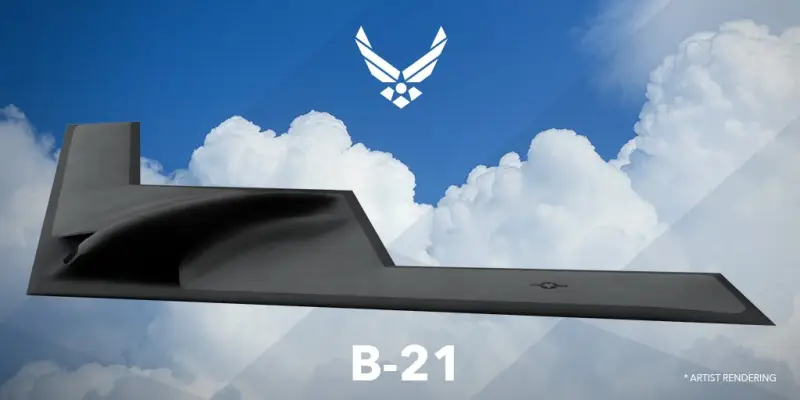
Early concept of the future B-21
A few weeks ago, the first flight of the experienced long-range bomber B-21 Raider developed by Northrop Grumman took place in the United States. The next few years will be spent on flight testing and fine-tuning the design, after which mass production of new aircraft will begin. In this regard, the issue of the size and cost of the series, as well as the costs of operating the future fleet of bombers, is already becoming relevant.
First projects
The current B-21 project was preceded by several research programs, during which the Pentagon and its contractors tried to determine the optimal appearance of a promising bomber, the most favorable timing for its development, etc. As this direction developed, views on the required quantity and acceptable cost of equipment also changed.
In the late nineties, the US Air Force put forward the 2037 Bomber plan, which explored the possibility of updating the bomber fleet in the distant future. In this document, the main attention was paid to the development of the design of equipment and the tactics of its use, while issues of quantity and cost faded into the background. At that time, it was believed that the replacement of existing aircraft with promising ones could be carried out in a one-to-one ratio. The cost of such re-equipment, due to the lack of even a preliminary design, could not be estimated.
The 2037 Bomber plan has been criticized by Congress, largely because of its proposed implementation timeline. The Pentagon was recommended to develop a similar plan, but designed for a less distant future. As a result, at the beginning of the 2018s, the XNUMX Bomber or Next-Generation Bomber (NGB) initiative appeared, in which the rearmament of bomber units was shifted to the left by two decades.
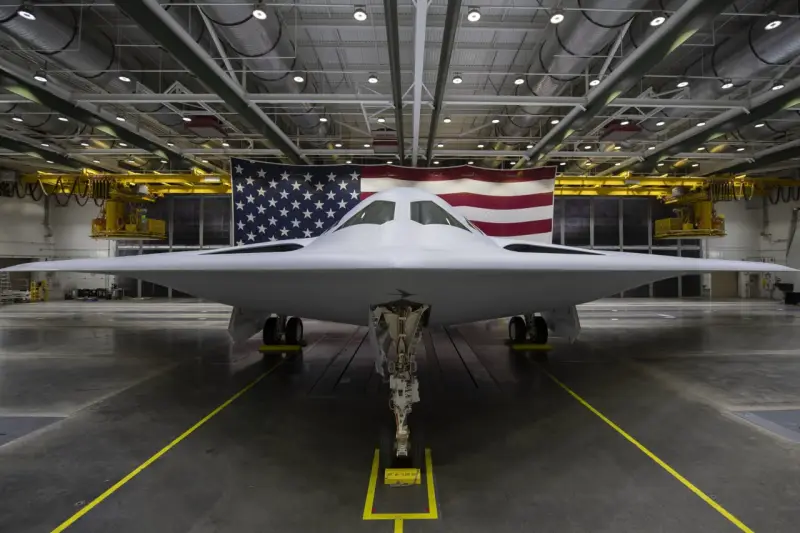
Ready prototype "Raider"
The military department and industry again worked out organizational and technical issues, but consideration of financial and other aspects was again postponed to the future. This or that work on NGB continued until the end of the XNUMXs and gave a certain result. However, long before the requirements were approved and full development was launched, the program was closed. This time, disputes about the prospects for the development of drumming led to this result. aviation as a whole.
Real calculations
The debate ended with the victory of supporters of preserving long-range aviation in its traditional form, and the Air Force was able to continue its research. In 2011, they announced the launch of the next program called Long-Range Strike Bomber (LRS-B), in which they planned to use the experience of two previous studies. By the middle of the decade, they were going to complete the research stage and move on to designing a new aircraft. It was supposed to be tested in the twenties, and by the middle of the decade mass production could begin.
Already in the early stages of the LRS-B program, it was possible to move beyond general tactical concepts and work out the issue of the required amount of equipment, as well as its cost. Ideally, the Pentagon planned to order 175 new bombers. They wanted to distribute 120 vehicles between combat units and subunits, and the rest were to become training vehicles or go into reserve. The total cost of the construction program was estimated at $50 billion in 2010 prices.
Subsequently, however, the estimated cost of the aircraft increased, which caused the disapproval of congressmen. But soon the military department and Congress came to a common opinion about the cost of the equipment. The maximum price for a production aircraft was set at $550 million in 2010 (more than $770 million at current prices). Subsequently, despite all the changes in plans, the marginal cost did not change.
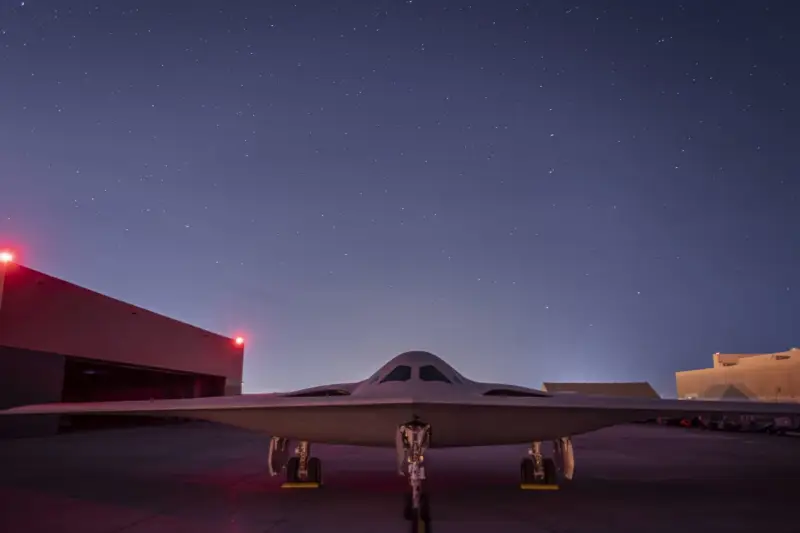
As it developed, the project became more complex and expensive, but the Pentagon could not count on increasing the acceptable price of the equipment. In this regard, already in 2013-14. serial construction plans were reduced to 80-100 aircraft. The Air Force command indicated that this size of the fleet does not reflect all the needs of long-range aviation and is associated only with the financial capabilities of the Pentagon.
In parallel with technical and financial issues, rearmament plans were worked out. It was decided that with the help of new LRS-Bs, at the first stage, they would complement the existing B-2A bombers and replace part of the existing B-1B fleet. In the future, they will completely replace the obsolete B-1Bs by that time, and a gradual re-equipment of units currently using B-52H aircraft will also begin. Later, these plans were repeatedly refined and adjusted, but did not fundamentally change.
Costs for "Raider"
In October 2015, the Pentagon completed the competitive portion of the LRS-B program and selected the winner. Northrop Grumman was awarded a contract to complete the design, construction and testing of a prototype aircraft and prepare a serial production line. In addition, this document stipulates the release of the first production batch of unspecified sizes. The total cost of all this work is determined at $21,4 billion.
During this period, representatives of the Pentagon and Congress regularly mentioned the need to build hundreds of new aircraft. The maximum cost of one aircraft remained at the same level, and there were no plans to revise it. Accordingly, the construction of the entire series, not counting development and maintenance costs, should have cost the taxpayer $55 billion in 2010 - significantly more than was indicated in the early stages of development of LRS-B.
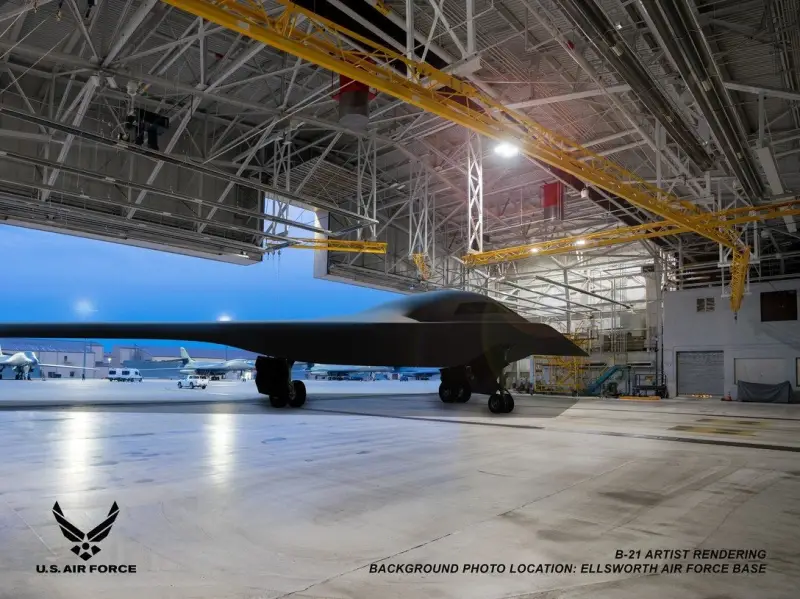
B-21 in the hangar of the combat unit - still drawn
In 2016, the Air Force refused to further publish information about the serial production of aircraft, because. letting such information fall into the hands of potential adversaries poses a threat to US national security. However, selected information is published from time to time. Thus, last year it was reported that plans for the construction of at least a hundred bombers were being maintained. The cost of each of them in current prices should be at the level of $700 million.
The existing contract for $21,4 billion stipulates the production of only the first production batch of Raiders. Judging by the cost, no more than a quarter or a third of the required number of bombers will be built. At the same time, the timing of the completion of such an order, as well as the emergence and execution of new contracts, are not disclosed for reasons of secrecy.
Recent reports may suggest that aircraft built under existing or pending contracts will be incomplete and have limited capabilities. In particular, it was mentioned that in the future, separate projects for the integration of certain weapons will be carried out. Whether the costs for these are included in the overall B-21 program plan is unknown. However, they are unlikely to stand out against the background of the total cost of construction and operation.
Strategic Savings
In the past, the development of strategic aviation of the US Air Force was faced with the problem of rising costs of aircraft. The project for the promising B-2A stealth bomber cost the Pentagon approximately $45 billion in 1997 prices—about $84 billion at current exchange rates. Due to excessive costs, only 21 aircraft were built, each of which, taking into account development costs, cost more than $2,1 billion (more than $4 billion in 2023 prices)
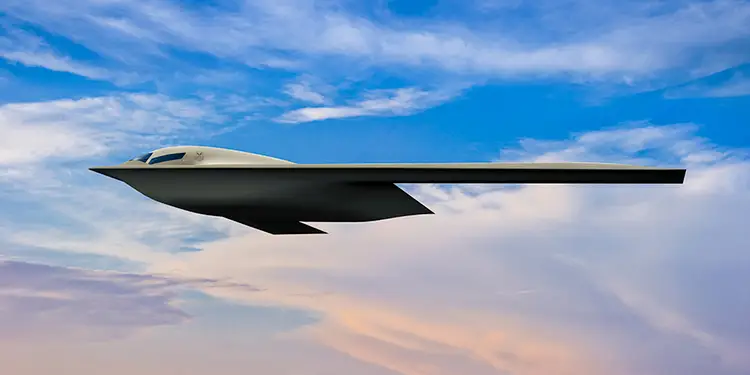
The financially unsuccessful B-2A program forced the Pentagon to reconsider plans for the development of long-range aviation, taking into account existing capabilities. In particular, it was necessary to extend the service life of not the newest B-52Hs, plan new programs for their repair and modernization, etc. In addition, already in the late nineties, shortly after the completion of the B-2A series, development of the 2037 Bomber program began.
One of the goals of all new projects, starting with the 2037 Bomber, was to reduce the cost of an individual aircraft and the construction program as a whole. Reportedly, in the current project LRS-B / B-21, which was successfully brought to the construction and testing of a prototype, these problems were successfully solved. Full financial details have not been reported in recent years, but overall the situation is said to remain optimistic.
According to available information, the price of one B-21 Raider will be in the range of $700-770 million. Such an aircraft will be approximately five times cheaper than the older B-2A with the same or higher technical, combat and operational characteristics. In total, it is planned to build at least a hundred new bombers, which will cost about 75-77 billion dollars - also less than what was spent on the previous generation aircraft.
Wishes and opportunities
Thus, the B-21 project is of particular importance to the US Air Force and strategic forces in general. It should ensure the full re-equipment of long-range aviation, which has not been carried out for several decades. Moreover, such processes will have a much larger scale than in the nineties. At the same time, the Pentagon plans to achieve all the desired results without an unacceptable increase in costs.
It is unknown whether all current plans will be implemented. Perhaps the optimism of the US Air Force is justified, and the construction of hundreds of bombers at $700-770 million each is realistic. However, another scenario is also possible, in which prices will rise again, and the Pentagon will have to reduce the size of the series or obtain additional funding. How events will develop will become known later. Construction of production B-21s will begin only in a few years and will continue until the next decade inclusive.
Information